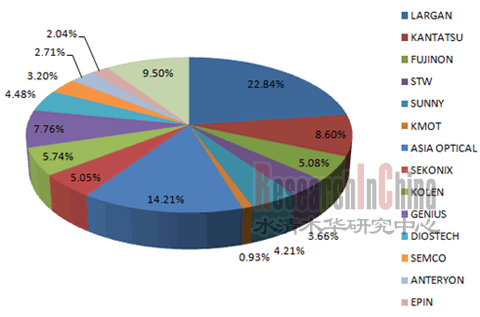 The latest research report of the Shuiqing Muhua Research Center pointed out that in 2010, the output value of the CMOS camera module was significantly increased compared with 2009, and the driving force came from three aspects. First, cell phone camera pixel values ​​have increased significantly, 2 million pixels have become mainstream; 3 million pixels are expected to become mainstream in 2011; 5 million pixels are expected to become mainstream in 2013. Second, smart phone shipments have increased significantly. The photographic pixels of smartphones are generally higher than those of ordinary mobile phones, and the average pixels exceed 3 million pixels. Third, the comprehensive promotion of 3G networks has made video calls possible, and a large number of dual-camera mobile phones have been launched.
The latest research report of the Shuiqing Muhua Research Center pointed out that in 2010, the output value of the CMOS camera module was significantly increased compared with 2009, and the driving force came from three aspects. First, cell phone camera pixel values ​​have increased significantly, 2 million pixels have become mainstream; 3 million pixels are expected to become mainstream in 2011; 5 million pixels are expected to become mainstream in 2013. Second, smart phone shipments have increased significantly. The photographic pixels of smartphones are generally higher than those of ordinary mobile phones, and the average pixels exceed 3 million pixels. Third, the comprehensive promotion of 3G networks has made video calls possible, and a large number of dual-camera mobile phones have been launched.
In the CMOS sensor field in 2010, Omnivision relies on BSI technology to gain Apple's favor and become the exclusive supplier of iPhone. Omnivision's shipments and revenue both increased significantly, operating profits increased by more than 15 times, and the industry’s number one position was further consolidated. Looking forward to 2011, Apple's second-generation iPad uses dual cameras, and the iPhone shipments will also increase significantly. Apple has already packaged Omnivision's BSI products.
BSI has become the next standard for CMOS sensors. Sony first invented BSI technology, Omnivision relies on TSMC to promote it, Samsung, SETI, APTINA and other manufacturers have also turned to BSI technology. During the technological transition period, the production capacity will not be able to meet the demand, especially the CMOS sensor used in notebook computers will have a meagre profit. The manufacturers are unwilling to produce and the demand is the most in short supply. It is expected that the CMOS sensors will be in shortage in the whole year of 2011.
In the field of lenses for CMOS camera modules, Taiwanese companies have become increasingly aggressive and Japanese companies have regressed. Daliguang continued to consolidate its position as the overlord of the industry, and its income has been far away from second place. The situation of Evergrande is obvious. The second-ranked Asia Optical relied on the mainland subsidiary Ethel Optics for a significant increase in shipments. Japanese companies face a sharp appreciation of the yen on the one hand and fierce competition from Taiwan companies on the other. Japanese companies are billion-dollar enterprises, and they don't give much support for CMOS camera lenses less than 1% of their revenue. For example, in KMOT, its lens revenue for CMOS camera modules shrank to 1/3 in 2009, and Fujinon also declined slightly. The remaining several Japanese companies have the possibility to withdraw from this field.
In the lens market for CMOS camera modules in 2010, the most amazing performance was Yujing Optoelectronics. This company relied on Motorola's V3 in 2005 and has a huge loss for four consecutive years from 2006 to 2009. However, Yujing Optoelectronics passed Apple's supplier certification in the second half of 2009 and became the second supplier of lenses for Apple's CMOS camera modules. In 2010, its revenue increased by nearly 250%. It is expected that the revenue of Yujing Optoelectronics in 2011 will increase more than 5 times than in 2009, and the gross profit rate will increase from -3% to 22%.
In 2010, the CMOS camera module assembly industry was in full swing. Foxconn was still the only company in the world. Lite-On's CMOS camera module assembly capacity in Dunnan was transferred to Lite-On Group. Both Samsung Motors and LG INNOTEK have increased their shipments, and Sharp, the world's largest Sharp, has fallen to third place worldwide. With the shrinking of Nokia's shipments, Sharp's shipments will decline.